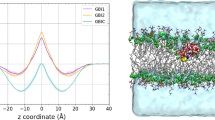Abstract
Mechanisms of proton transport were investigated in planar phospholipid bilayer membranes exposed to aspirin (acetylsalicylic acid), acetaminophen (4-acetamidophenol), benzoic acid and three aspirin metabolites (salicylic acid, gentisic acid and salicyluric acid). The objectives were to characterize the conductances and permeabilities of these weak acids in lipid bilayer membranes and then predict their effects on mitochondrial membranes. Of the compounds tested only aspirin, benzoate and salicylate caused significant increases in membrane conductance. The conductance was due mainly to proton current at low pH and to weak acid anion current at neutral pH. Analysis of the concentration and pH dependence suggests that these weak acids act as HA2 −-type proton carriers when pH ≈ pK and as lipid soluble anions at neutral pH. Salicylate is much more potent than aspirin and benzoate because salicylate contains an internal hydrogen bond which delocalizes the negative charge and increases the permeability of the anion. Model calculations for mitochondria suggest that salicylate causes net H+ uptake by a cyclic process of HA influx and A− efflux. This model can explain the salicylate-induced uncoupling and swelling observed in isolated mitochondria. Since ingested aspirin breaks down rapidly to form salicylate, these results may clarify the mechanisms of aspirin toxicity in humans. The results may also help to explain why the ingestion of aspirin but not acetaminophen is associated with Reye's syndrome, a disease characterized by impaired energy metabolism and mitochondrial swelling.
Similar content being viewed by others
References
Flower RJ, Moncada S, Vane JR: Analgesic-antipyretics and anti-inflammatory agents. In: AG Gillman, LS Goodman, TW Rail and F Murad (eds.) The Pharmacological Basis of Therapeutics, seventh edition. Macmillan, New York, 1985, pp 674–715
Rainsford KD: Aspirin and the Salicylates. Butterworths, New York, 1984
Aprille JR: Reye's syndrome: patient serum alters mitochondrial function and morphology in vitro. Science 197: 908–910, 1977
Forsyth BW, Horwitz RI, Acampora D, Shapiro ED, Viscoli CM, Feinstein AR, Henner R, Holabird NB, Jones BA, Karabelas ADE, Kramer MS, Miclette M, Weiss JA: New epidemiologic evidence confirming that bias does not explain the aspirin/Reye's syndrome association. J Am Med Assoc 261: 2517–2524, 1989
Haas R, Parker WD, Stumpf D, Eguren LA: Salicylate-induced loose coupling: protonmotive force measurements. Biochem Pharmacol 34: 900–902, 1985
You K: Salicylate and mitochondrial injury in Reye's syndrome. Science 221: 163–165, 1983
Brody TM: Action of sodium salicylate and related compounds on tissue metabolism in vitro. J Pharmacol 117: 39–51, 1956
Whitehouse MW: Biochemical properties of anti-inflammatory drugs III. Uncoupling of oxidative phosphorylation in a connective tissue (cartilage) and liver mitochondria by salicylate analogues. Biochem Pharmacol 13: 319–336, 1964
Thompkins L, Lee KH: Studies on the mechanism of action of salicylates IV: Effect of salicylates on oxidative phosphorylation. J Pharmaceutical Sci 58: 102–105, 1969
Ramsay RR, Rashed MS, Nelson SD: In vitro effects of acetaminophen metabolites and analogs on the respiration of mouse liver mitochondria. Arch Biochem Biophys 273: 449–457, 1989
Walter A, Gutknecht J: Permeability of small nonelectrolytes through lipid bilayer membranes. J Membrane Biol 90: 207–217, 1986
Gutknecht J: Proton conductance caused by long-chain fatty acids in phospholipid bilayer membranes. J Membrane Biol 106: 83–93, 1988
Gutknecht J: Salicylates and proton transport through phospholipid bilayer membranes: A model for salicylate-induced uncoupling and swelling in mitochondria. J Membrane Biol 115: 253–260, 1990
Dilger JP, McLaughlin JGA, McIntosh TJ, Simon SA: The dielectric constant of phospholipid bilayers and the permeability of membranes to ions. Science 206: 1196–1198, 1979
Scarpa A: Transport across mitochondrial membranes. In: G Giebisch, DC Tosteson and HH Ussing (eds.) Membrane transport in biology, Vol II Springer-Verlag, New York, 1978, pp 263–355
Garlid KD, Beavis AD: Swelling and contraction of the mitochondrial matrix II. Quantitative application of the light scattering technique to solute transport across the inner membrane. J Biol Chem 260: 13434–13441, 1985
McLaughlin SGA: Salicylates and phospholipid bilayer membranes. Nature (London) 243: 234–236, 1973
Andersen OS, Finkelstein A, Katz I, Cass A: Effect of phloretin on the permeability of thin lipid membranes. J Gen Physiol 67: 749–771, 1976
McLaughlin SGA, Dilger JP: Transport of protons across membranes by weak acids. Physiol Rev 60: 825–863, 1980
Pauling L: The nature of the chemical bond, third edition. Cornell University Press, Ithaca, New York, 1960
Joy MM, Cutler DJ: On the mechanism of transport of salicylate and p-hydroxybenzoic acid across humen red cell membranes. J Pharm Pharmacol 39: 266–271, 1987
Cunarro J, Weiner MW: Mechanism of action of agents which uncouple oxidative phosphorylation: direct correlation between proton-carrying and respiratory-releasing properties using rat liver mitochondria. Biochim Biophys Acta 387: 234–240, 1975
Nicholls DG: Bioenergetics: An introduction to chemiosmotic theory. Academic Press, New York, 1982
Author information
Authors and Affiliations
Rights and permissions
About this article
Cite this article
Gutknecht, J. Aspirin, acetaminophen and proton transport through phospholipid bilayers and mitochondrial membranes. Mol Cell Biochem 114, 3–8 (1992). https://doi.org/10.1007/BF00240290
Issue Date:
DOI: https://doi.org/10.1007/BF00240290




